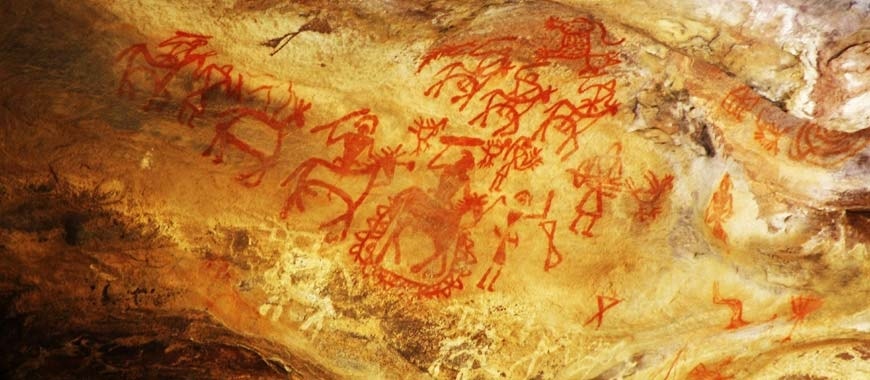Bhimbetka

The Rock Shelters of Bhimbetka are located about 45 km south east of Bhopal on the road to Hoshangabad. The site spread over 10 km in length and about 3 km in width has more than 700 rock shelters, of which over 400 have paintings. The earliest human activities are known from the numerous stone tools including handaxes, cleavers and also the pebble tools.
The latter pertinently was found in primary contexts. The continuity of human evolution from the Lower Palaeolithic Period is noticed by the smaller size of stone tools in the following Middle Palaeolithic Period besides new tools like scrapers. During the Upper Palaeolithic Period newer tool types like: blades, borers and burins had also emerged. However, it is in the Mesolithiic Period that there is a clear change in the materials and tool typology. Earlier, the tools were largely made of quartzite and sandstone, whereas the tools being made in the Mesolithic Period were most often of chalcedony. The stone tools of this period include blades, triangles, trapezes, crescents besides quern and muller.
The Mesolithic culture at Bhimbetka continued much longer as understood by the presence of Chalcolithic potteries in otherwise Mesolithic contexts. By the Early Historic times it appears that interaction with the surrounding cultures became more pronounced. This is evidenced by the presence of rock-cut beds in a rock shelter on the top portion of an inselberg like outcrop not far from the later built temple at this site. In all respect it resembles the Sallekhana spots observed in South India.
The cave also has a small inscription of the Maurya/Sunga period. Within the general area of Bhimbetka Group of rock shelters small stupas have been found at Bhimbetka, near Bhoranwali, at Bineka, at Lakhajuar and midway between Lakhajuar and Bhimbetka. At Bineka besides the stupa enclosure wall and other structures were found. There are a large number of Shanka Lipi inscriptions in the Bhimbetka cluster of rock shelters.
However it is the rock paintings of Bhimbetka that steals the limelight. Of particular interest to the tourist are the Auditorium Rock Shelter, Zoo Rock and Boar Rock in Bhimbetka Cluster. The earliest endeavour here other than for mere run of the mill activities for survival is the engravings of small cup like depressions at the end of the Auditorium Rock Shelter, which is dated to nearly 100000 years. Near the end of this tunnel there is a cluster of painting depicting a hunter, deer, tiger cattle and stylised peacock. Further ahead on the same path one comes across the Zoo Rock Shelter, which qualifies as the most densely painted rock shelter, paintings spanning from the Mesolithic to the Mediaeval. The paintings here include those of A Mesolithic boar painted in dark red, animals like: elephant, rhinoceros, boar, barasingha, spotted deer and cattle and snake, etc. Later paintings include battle scenes painted in red and an elephant painted in white. The Boar Rock, which is the last among the rock shelters accessible for tourist has a depiction of a mythical boar with horns that is many more times larger than the human being chased by it.
Open from sunrise to sunset .